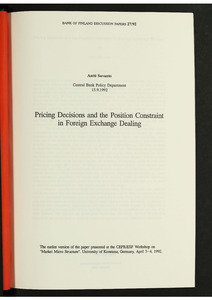Pricing decisions and the position constraint in foreign exchange dealing
Suvanto, Antti (12.09.1992)
Numero
27/1992Julkaisija
Bank of Finland
1992
Julkaisun pysyvä osoite on
https://urn.fi/URN:NBN:fi:bof-201908081373Tiivistelmä
The paper attempts to formalize dealer behaviour in the foreign exchange market. The three key assumptions used in the analysis are price sensitivity of customer orders and profit maximization by dealers who are constrained by the closed position target for the end of the day. As a market maker the dealer provides liquidity services to customers by making two-way prices and by standing ready to trade at these prices on immediate demand. The paper begins with a simple one-period model assuming a monopoly dealer. This is extended to sequential pricing behaviour under transactions uncertainty (stochastic order flow). The role of information is examined separately. While the assumption of a monopolistic market structure is admittedly highly unrealistic in the case of the foreign exchange market, the same model structure also works well in a competitive environment. Competition enters the analysis in the form of customer flows and interdealer transactions. The overall picture of the market structure and price dynamics that emerges from the analysis is broadly consistent with observable facts. The results are consistent with the efficient market hypothesis in the sense that there is no possibility that any of the customers or other dealers could predict the dealer's forthcoming quotations on the basis of the dealer's past pricing behaviour. Under pure transactions uncertainty and in the absence of new information, the dealer is reluctant to make a large adjustment to prices, because frequent price revisions are generally revenue-reducing. This does not apply to situations where new information ruts the market. Any new information on forthcoming customer orders will cause a prompt change in the quoted price. Price adjustments are, however, limited by the sensitivity of customers to small price differentials. Because dealers can send orders to each other in the interbank market, the sensitivity of incoming orders to small price differentials is large. As a result, the prices quoted by different dealers cannot deviate much from each other. The price making power of each dealer is reflected in the spread. Competition reduces the spread and it approaches zero once interdealer transactions are allowed for. Under pure transactions uncertainty, the spread tends to be constant. Under competitive conditions, when the spread is very small, prices quoted by all dealers are practically equal and the share of interbank transactions in the total volume of trade is very large. Intraday volatility of exchange rate quotations stems from two sources, one representing normal order flow and the other the arrival of new information. Price uncertainty would be small if transactions uncertainty was its only source and if order flows were purely stochastic. Any new information on forthcoming customer orders increases price uncertainty. ln addition to temporal price uncertainty, instantaneous price uncertainty is present because the dealer has to make a binding two-way price without knowing what prices his competitors are quoting at the same moment. This prevents the spread from diminishing indefinitely. In times of increasing uncertainty the spread tends to widen as a result of heterogeneous and asymmetric information.
